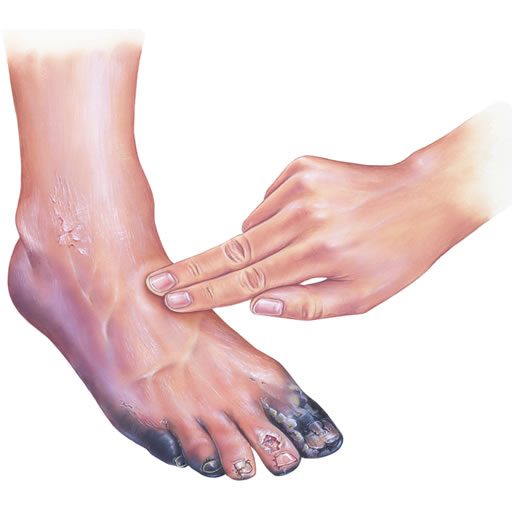Gangrene is more common than most people realize. It develops when the blood supply to a part of the body is cut off. Without oxygen, tissues start to die. Diabetes, smoking, and peripheral vascular disease are often behind it.
According to reports, thousands of people in India face gangrene every year. Many believe that surgery is the only way to treat it. The truth is that safe and effective non-surgical methods are available.
Exploring gangrene treatment options gives patients a chance to heal without removing large portions of tissue.

Understanding Gangrene and Its Risks
Gangrene is not just one condition. It appears in different forms. Dry gangrene develops slowly when circulation drops, often in people with diabetes. Wet gangrene is linked to infection in wounds that do not heal. It spreads fast and can turn dangerous quickly. Gas gangrene, caused by certain bacteria, is the most aggressive and life-threatening if ignored.
Risk factors matter. High blood sugar, smoking, vascular disease, or poor circulation raise the chances. Even small cuts on the feet can become severe. If untreated, gangrene may lead to sepsis, shock, or amputation. Early recognition and timely care matter. In some cases, gangrene treatment without surgery may be an option.
Gangrene Treatment Options You Should Know
-
Medical Therapies for Early Stage Cases
Medication is often the first step in early gangrene treatment. Doctors use antibiotics to fight infections. This stops bacteria from spreading deeper into tissue. Blood thinners may also be prescribed. These improve circulation and help oxygen reach starved areas. Some patients benefit from vasodilators. These widen blood vessels so more blood can flow to weak tissues.
For diabetic patients, blood sugar control becomes part of the treatment. High sugar levels damage circulation further and make wounds slower to heal. Keeping sugar in check can prevent complications.
These therapies are not quick fixes. They work overtime. Doctors usually schedule follow-ups to check if the treatments are working. Plans may be adjusted depending on progress. For many patients, medical therapy is enough to slow the damage and prepare the body for other non-surgical solutions.
-
Wound Care and Specialized Dressings
Proper wound care is one of the strongest paths to gangrene treatment without surgery. Cleaning and protecting wounds supports healing and prevents bacteria from spreading. Good care can also stop infection from reaching healthy skin.
Key practices include:
- Clean the wound every day with a sterile solution.
- Use antimicrobial dressings to stop bacteria from growing.
- Try foam or hydrogel dressings. They keep the wound moist.
- Protect the wound from friction, pressure, or dirt.
There are advanced options too. One of the most common is negative pressure wound therapy. A small vacuum device pulls out fluids and bacteria. This keeps the area clean and helps reduce swelling. It also speeds up healing. With regular care from a wound specialist, recovery without surgery becomes more likely.
-
Hyperbaric Oxygen Therapy
Hyperbaric oxygen therapy is a modern and effective option. Patients stay in a pressurized chamber and breathe pure oxygen. This approach increases oxygen levels in the blood. Oxygen then reaches areas that were previously starved.
The benefits include:
- Boosted tissue repair in low-circulation zones
- Reduced swelling and inflammation
- Stimulation of new blood vessel growth
- A stronger immune response against infections
This therapy is useful for diabetic foot ulcers. It is painless and non-invasive. Patients often find it easier to manage than surgical approaches. Sessions may be repeated several times a week, depending on the case.
Lifestyle Adjustments and Prevention
Healing is not only about treatment. Lifestyle changes play a big role in both recovery and prevention. Small steps can lower the chances of gangrene returning. Doctors usually recommend the following:
- Blood sugar control through balanced diets and regular testing
- Exercise, such as walking, to improve circulation
- Having foods rich in vitamins, minerals, and protein to repair tissues
- Daily foot care, including inspections, moisturizers, and well-fitting shoes
- Quitting smoking to improve circulation and overall healing
These changes make treatments more effective. They also support the body in preventing new wounds from becoming serious. Prevention often becomes the best long-term solution.
Endovascular Recanalization (Angioplasty/Atherectomy)
Endovascular recanalization gets blood flowing in blocked arteries. It helps stop gangrene from getting worse. This treatment is minimally invasive. It reduces tissue loss and supports healing. Surgery risks stay low. Advanced imaging makes the procedure precise. It is safe, effective, and a popular non-surgical option for saving limbs.
Exploring Gangrene Treatment Without Surgery
Many patients actively look for gangrene treatment without surgery. They want to avoid tissue removal and focus on healing methods. In many cases, this is possible. A mix of wound care, oxygen therapy, and medications can bring results.
Every treatment plan is different. It depends on how serious the gangrene is and what other health issues a person has. Some people try natural remedies. These can help with circulation. However, they cannot replace proper medical care. Evidence-based treatments are still the safest way to go.
The strongest results often come from combining therapies. A patient may receive antibiotics to fight infection, use specialized dressings for wound care, and undergo hyperbaric oxygen therapy at the same time. Together, these methods give a real chance of recovery without needing surgery.
Conclusion
Gangrene is serious, but surgery is not the only answer. Today, healthcare gives safer gangrene treatment options. These focus on healing and preventing damage. Medicines fight infections and improve blood flow. Wound care and smart dressings protect skin and help it recover. Hyperbaric oxygen therapy steps in, too. It feeds oxygen deep into the bloodstream and speeds up repair. Lifestyle changes strengthen these methods. Prevention plays just as big a role as treatment.
With guidance from Dr Gaurav Gangwani, patients can explore safe solutions that avoid major surgery. The key is early action, consistent care, and continuous prevention. Taking steps in time makes recovery possible and builds a healthier future.



